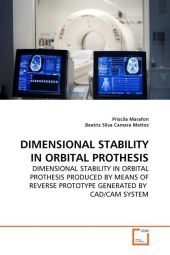 Neuerscheinungen 2010Stand: 2020-01-07 |
Schnellsuche
ISBN/Stichwort/Autor
|
Herderstraße 10
10625 Berlin
Tel.: 030 315 714 16
Fax 030 315 714 14
info@buchspektrum.de |

Priscila Marafon, Beatriz Silva Camara Mattos
(Beteiligte)
DIMENSIONAL STABILITY IN ORBITAL PROTHESIS
DIMENSIONAL STABILITY IN ORBITAL PROTHESIS PRODUCED BY MEANS OF REVERSE PROTOTYPE GENERATED BY CAD/CAM SYSTEM
2010. 64 S.
Verlag/Jahr: VDM VERLAG DR. MÜLLER 2010
ISBN: 3-639-26713-3 (3639267133)
Neue ISBN: 978-3-639-26713-6 (9783639267136)
Preis und Lieferzeit: Bitte klicken
This study is to evaluate the dimensional stability of orbital prosthesis. Face computerized tomography of 15 adults were processed in CAD software to produce 30 reverse tridimensional models of the orbital region. These models were then processed in the CAM system to generate surface prototypes of the orbital region. Two facial impressions of each subject provided 15 pairs of cast models and orbital defects were performed of each stone model. The surface prototypes were adapted in the casts and then flasked to be processed in silicone. The demarcation of anthropometric landmarks defined 31 linear measurements, used to evaluate the dimensional stability of the orbital prostheses.Conclusion, the comparative analyses of the measurements, observed in the prostheses and in the opposite sides that originated the surface prototypes, showed that silicone orbital prostheses presented similar vertical, transversal and oblique dimensions, as well as similar depth.The dimensional stability suggests that the CAD/CAM system evaluated herein may be used with clinical purposes.


